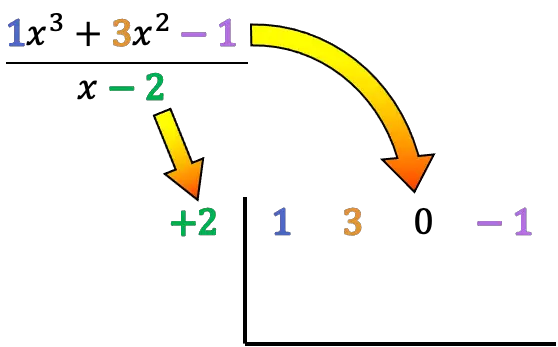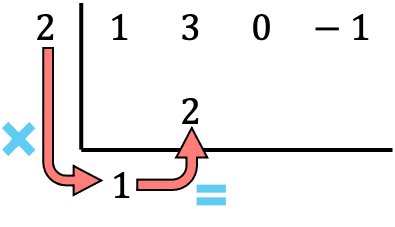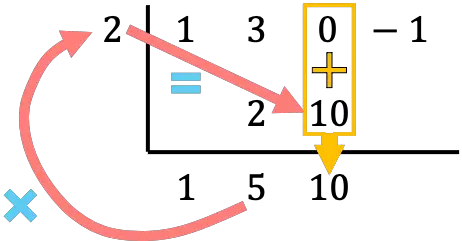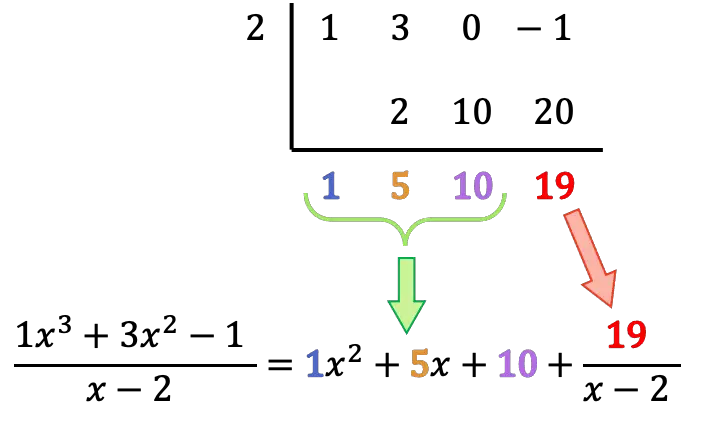On this post we explain how to use synthetic division to divide polynomials. Here you will see examples and exercises solved step by step of the polynomial synthetic division. AFinally, you will find all the applications of this method.
Table of Contents
What is the synthetic division?
The synthetic division, also called polynomial synthetic division, is an algebraic method for dividing any polynomial by polynomials of the form x-c. The synthetic division is a shortcut method, so it used to divide polynomials with fewer calculations than the long division of polynomials.
However, the polynomial synthetic division has many more uses. For example, it is also used to find the zeros (or roots) of a polynomial, to factor a polynomial or even to evaluate a polynomial. Below we will see how to use synthetic division of polynomials to do all these operations.
How to do synthetic division
As we have seen, the main use of synthetic division is to divide a polynomial by a binomial, that is, to perform a division like this:
Note that to use synthetic division, the divisor polynomial must always be composed of an x (with coefficient equal to 1) and a constant term (positive or negative), otherwise the synthetic division algorithm cannot be applied.
To apply the synthetic division, a whole procedure must be followed, so below we are going to solve an example step by step to see how the polynomial synthetic division is done.
Example of synthetic division
- Solve the following division of polynomials using synthetic division:
First of all we must draw two perpendicular lines, and then place the dividend and the divisor as follows:

As you can see, we must put the coefficients of the dividend polynomial at the top arranged from highest to lowest degree, and we place the constant term of the divisor polynomial on the left of the box changed sign.
Note: if the dividend polynomial does not have a term of a certain degree, a 0 is put in its place. For example, in this case the polynomial does not have a monomial of degree 1, so we have written a 0 in its place.

Once we have place the polynomials, we bring down the leading coefficient to the bottom row:

Now comes the step that characterizes polynomial synthetic division: multiply the number in the bottom line by the number on the left and place the result beneath the next coefficient:

And we add the numbers in the column, writing the result of the sum in the bottom row:

Thus, synthetic division method consists of repeating this process. Therefore, we do the same process again: we multiply the number below by the number on the left, we put the result in the next column, and finally we do the sum of the numbers that are vertically aligned:

And we repeat the same procedure successively until the end. First we calculate the product of the number on the bottom line by the number on the left, then we place the result in the next column, and finally we add the numbers in the same column:

And when we have completed all the columns it means that we have finished dividing the polynomials.
So we only need to write the result of the division of the polynomials:
- The remainder of the division of the two polynomials is the last number in the row below, so in our case the remainder is equal to 19.
- The quotient of the polynomial division is determined by the other values obtained, which are the coefficients of the polynomial of the quotient. The first number starting from the right corresponds to the coefficient of the term of degree 0 (constant term), the next number is the coefficient of the term of degree 1, the next one of degree 2, the next one of degree 3, … and so on until the end. Therefore:

Practice problems on dividing polynomials using synthetic division
Below you have several exercises solved step by step on polynomial synthetic division so that you can practice and understand better how to solve divisions of polynomials using this method.
Problem 1
Perform the following division of polynomials using synthetic division:

Therefore the result of the division of the two polynomials is:
Problem 2
Divide the following two polynomials using synthetic division:
In this particular case, the dividend polynomial does not have a second degree term, so we must put a zero in its place:

So the result of the polynomial division is:
Problem 3
Find the result of the following division of polynomials using synthetic division:

Thus, the result of dividing the two polynomials is:
Problem 4
Find the value of the unknown m so that the remainder of the following division of polynomials is 5:
Since the divisor is of the form (x-c) or (x+c) we can apply the polynomial synthetic division rules:

Now we set the remainder obtained equal to 5, because the remainder has to be 5:
And we solve for the variable m:
Therefore, when the variable m is 3, the remainder of the division of the polynomials will be equal to 5.
Problem 5
Determine the value of the unknown m so that the remainder of the following polynomial division is 3:
Since the divisor is of the form (x-r) or (x+r) we can use polynomial synthetic division algorithm:

Use the distributive property to compute the last multiplication:
And the calculation of the remainder of the division is:
Now we set the expression of the remainder obtained equal to 3, since the remainder of the division must be 3:
And we solve the resulting equation to determine the value of the unknown m:
Therefore, m must be 2 for the remainder of the polynomial division to be 3.
More applications of synthetic division
As explained above, synthetic division is used mainly to compute a division of polynomials. However, it also serves to perform other calculations, below we will see each and every one of them.
Zeros of a polynomial
You can easily determine the zeros (or roots) of a polynomial using the synthetic division. In case you don’t know what the root of a polynomial is, let’s see its definition:
The zeros (or roots) of a polynomial are the values of x for which the polynomial is zero.
On the other hand, we know from the remainder theorem that if the evaluation of a polynomial at a certain value is zero, the remainder of the division of that polynomial by
must also be 0.
Therefore, if we obtain a remainder equal to 0 when dividing a polynomial by a binomial
using synthetic division, it means that
is a root of the polynomial
For example, we are going to check whether is a root of the polynomial
applying the synthetic division method:

Since the remainder obtained from the synthetic division is zero, the value is a root of the polynomial
Furthermore, we can factor the polynomial with the quotient obtained in the synthetic division:
Evaluating polynomials
Although it may seem surprising, a polynomial can be evaluated using synthetic division and the remainder theorem.
But, obviously, to be able to do this, you must know what the remainder theorem is. If this is not the case, you can search for the explanation of the remainder theorem on our website.
So, applying the remainder theorem we can evaluate any polynomial. Let’s see how to do it by solving an example:
- Evaluate the polynomial
at the value
applying synthetic division:
To evaluate the polynomial at the value all we have to do is use synthetic division with the polynomial and that value:

So, from the remainder theorem, we know that the evaluation of a polynomial is the remainder of the polynomial division. Thus, the evaluation of the polynomial at is -9.
On the other hand, we can verify that the calculations are correct by evaluating the polynomial as usual: